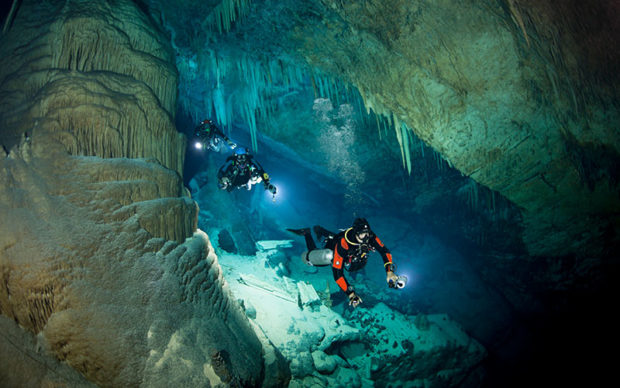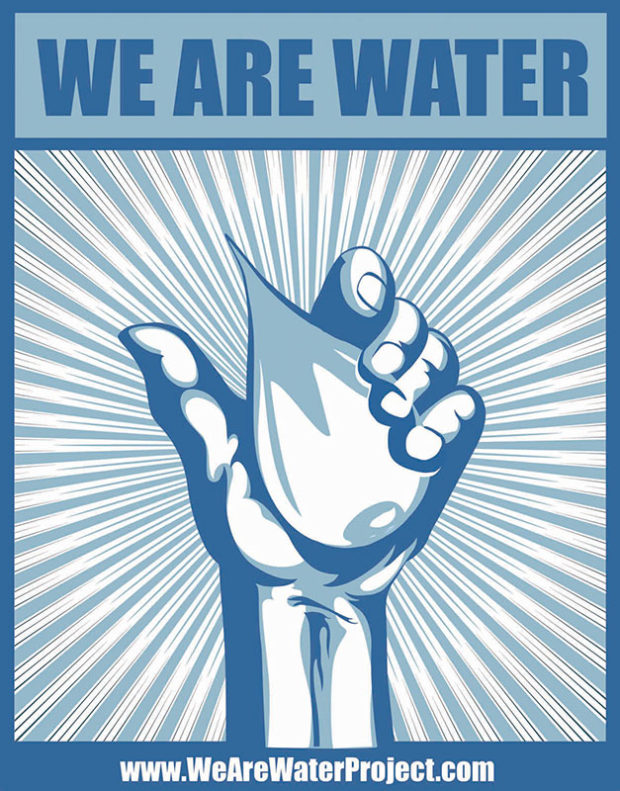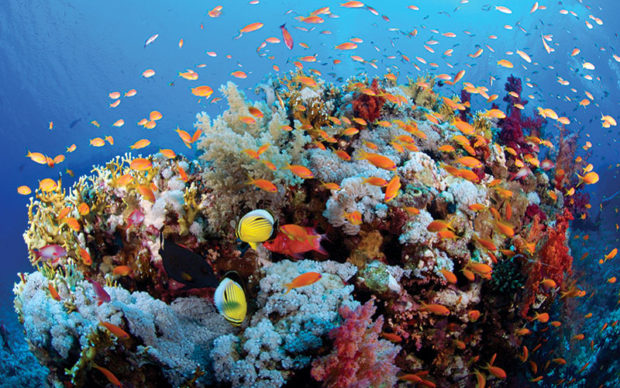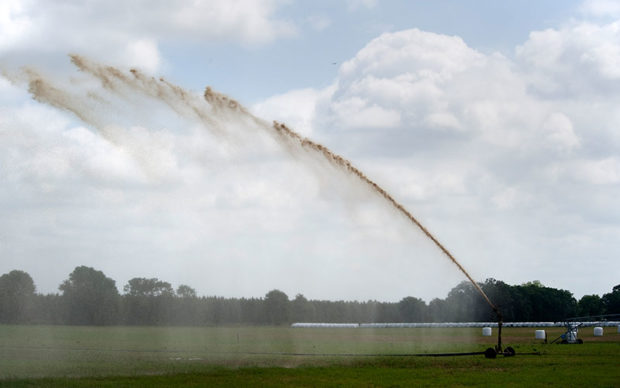We Are Water

Text and Photography by Jill Heinerth
The bright lights attached to the Betacam broadcast camera snapped to life and the news show’s producer exchanged a nod with the cameraman. A local translator deciphered the meteoric Spanish into broken English and awaited my response. I had just climbed 6,000 feet (1800m) out of a mountain canyon and emerged in a rustic Mexican settlement nestled in the Sierra Madres Mountains. One month in the valley resurgence, diving on an expedition with Dr. Bill Stone had transformed me from a curious cave diver into an enthusiastic explorer. I was eager to regale the news crew with stories of dangerous mudslides and unexpected siphons, of defeating harsh weather and of uplifting discovery. Interviews with Dr. Noel Sloan attested to the physical challenges of diving deep in Huautla. Bill elucidated on the emerging technology of diving. It was my turn to share my perspectives with the world about uncovering new passages inside the earth.
“What makes you think a woman can cave dive?” he asked. “Why would a woman take such risks? Why do you do it?”
For a moment, I felt trivialized. I was, in the producer’s eyes, demoted from explorer to thrill seeker. Worse perhaps, I was a risk taker, a silly woman endangering others. There was no amount of climbing rope that could bridge the newsman’s gender gap. It may have been the most perilous chasm I had to cross during my early expedition career. I have crossed that same chasm many times since, and I’ve looked back on that 1995 odyssey many times to consider my motivations. What is it that makes me want to dive? What is it that drives me to continue?
 Ironically, during that 1995 U.S. Deep Caving Team Project I had an epiphany, which became the impetus that directed my purpose for diving thereafter. We were exploring a region that would turn out to boast the known world’s deepest cave. Imagine a mountain range filled with sink holes that carry rain water deep into the earth. Cascading through vertical fissures and underground lakes, cavers plummet into the planet on miles of vertical rope, reaching hidden bodies of water that require the technical expertise of cave divers. From the resurgence in the mountain valley, it’s the reverse: follow canyon streams that penetrate deep underwater caves to reach dry openings that offer keyhole passages to the mountaintop above. It’s a caver’s dreamland, and yet for the indigenous people of the region it is a nightmarish landscape that sucks up their precious water. Each family dedicates a person to the full time occupation of fetching and carrying water for miles. A small child strains with two plastic buckets lashed on a shouldered branch, crucified daily to the tortures of weight that distorts their posture to a misshapen hunch.
Ironically, during that 1995 U.S. Deep Caving Team Project I had an epiphany, which became the impetus that directed my purpose for diving thereafter. We were exploring a region that would turn out to boast the known world’s deepest cave. Imagine a mountain range filled with sink holes that carry rain water deep into the earth. Cascading through vertical fissures and underground lakes, cavers plummet into the planet on miles of vertical rope, reaching hidden bodies of water that require the technical expertise of cave divers. From the resurgence in the mountain valley, it’s the reverse: follow canyon streams that penetrate deep underwater caves to reach dry openings that offer keyhole passages to the mountaintop above. It’s a caver’s dreamland, and yet for the indigenous people of the region it is a nightmarish landscape that sucks up their precious water. Each family dedicates a person to the full time occupation of fetching and carrying water for miles. A small child strains with two plastic buckets lashed on a shouldered branch, crucified daily to the tortures of weight that distorts their posture to a misshapen hunch.
It was there, in the beautiful, mysterious caves of Huautla, that I discovered my true motivations in diving. I wanted to know where the drinking water came from and where it went. I wanted to understand why nobody told the locals that having their toilet upstream from their neighbor’s kitchen was a bad idea. I wanted to comprehend how Americans could wastefully discard clean water from a running tap while we mindlessly satiated our senses brushing our teeth. I wanted to follow water’s journey where ever it would lead me: from cave to spring, river to estuary, and mangrove to coral reef.
For the first time in history, fresh water has become a finite resource. Many experts agree that, without significant changes in water policy, wars of the 21st century will be fought, not over oil, but for control of clean water. I live on top of the most abundant aquifer on the planet, yet many of my neighbors scarcely understand where their water comes from or how they might be unintentionally polluting that scarce resource. Ask a child where their water comes from and many will tell you, “The tap.” Somehow we have lost the real connection to the water that flows underground between the grains of sand or through vast cave tunnels that I call my workplace.

Leading a very fortunate life filled with great adventures around the world, I decided it was important to put the pieces together for people and help them understand that all we have wrought upon the surface of our land will be returned to us to drink.
We look for life in space, sending probes, rovers and robots searching for water, yet we have taken our own water for granted. Earth is a water planet, shining a unique blue in the vastness of space. Yet less than three percent of the water on this planet is fresh and most of that is locked up in ice. Less than one percent of the water supply can be used for drinking. There is nothing more precious than potable fresh water and nothing is shrinking faster as we overpopulate this big blue orb.
Traveling on expeditions around the globe, I see common problems and ingenious solutions, yet for some reason the lessons learned are not carrying forward to the global community. Diving in Tank Cave in Australia’s Mount Gambier I can see the etched lines on the wall of the dry entry where the water table has receded by almost a meter. Each year the dive starts a little further back in the cave where the water laps upon a new larger shoreline, while farmers above put up “For Sale” signs on drying farms. Snorkeling among the mangroves of the Florida Keys, I swim in a bright green algae sheen of nutrient-laden water shrouding the previous crystal visibility. Fertilizers and septic tanks enrich the bloom that washes from the land and creeps ominously towards the precious national monument of the coral reefs. In Bonaire I watch pulverized plastics and the refuse of humanity wash ashore as cruise ships brimming with mindless merrymakers drift by.
Given this reality, one could question my love for the underwater world and my hope that mankind will protect it. The truth is that I am eternal optimist. Experience the joy of feeding a stingray in the shallow waters of Grand Cayman and you will understand my passion. Be carried by the currents in the emerald seas while you meet a grizzle-faced Wolf Eel and you will know my love for our ocean’s inhabitants. Watch a child fill a bucket with drinking water while you wear dive gear worth more money than her family can imagine, and you will know why I have to speak out.

On a local level, we can all take small actions to conserve and protect water resources. North Americans use five times more water than Europeans and many multiples more than the rest of humanity. Our wasteful actions are spurred by our dysfunctional love affair with golf-course style lawns and the wasteful use of a cheap and plentiful water supply within our homes. In the United States, the average family pays just one dollar per day for access to hundreds of gallons of ‘on demand’ water. Our unknowing contribution to pollution comes through action at home and work as well as an intellectual detachment to our water footprint. We wantonly use up bottled water without understanding that it takes five bottles worth of ‘water resources’ to make one, and many more to deal with the trash.
On a regional level, we have somehow become disconnected from our food supply. We go to the grocery store, and there, neatly stacked and brightly packaged, are all the food choices a family could possibly want. Our consumer culture of the last two decades has fostered habits that use and pollute water on a grand scale.
Globally, we have forgotten that many people are not as fortunate as we are. Millions of women spend their entire day walking on dangerous roads to fetch water for their families. They become the victims of despair and miss out on the opportunity for education and advancement. They do whatever is necessary to tend to their children who are sick from water tainted with toxic chemicals and dangerous microbes. History continually shows us that desperation on this level leads to global conflict and unrest.
Yet even with these dire observations, I have to remain optimistic about our ability to understand these critical issues and do something about it. We’re in the eleventh hour, yet it only takes a determined collective will and simple actions to move towards a more harmonious and sustainable future.
My goal with the We Are Water Project is to help people learn about their local watershed and promote general water literacy. I want people to understand where their water comes from, how they might be polluting it, and how they can conserve it for future generations. With knowledge comes power and I believe when people are better connected with their water resources, they will want to do something about it. Most importantly, I want to inspire people to have a love affair with water. If they swim, dive or paddle in it, they’ll want to do it again. They will protect what they love and understand, and if everyone considers that both their bodies and our planet are 70 percent water, they will understand that We Are Water.
You are already an important part of the solution. Diving is a rare and exciting privilege and your presence in this sport already separates you from the majority of the population. As you relate tales of swimming in a salmon run or plunging off the Zodiac to join a school of Pacific White-Sided Dolphins, you will inspire others to experience the unique underwater world and help create the next generation of water ambassadors. Your motivation for diving will help others understand the precious nature of our underwater world.
For more visit: www.intotheplanet.com
Leave a Comment







